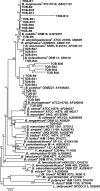Microbial community structure and dynamics of dark fire-cured tobacco fermentation
- PMID: 17142368
- PMCID: PMC1800767
- DOI: 10.1128/AEM.02378-06
Microbial community structure and dynamics of dark fire-cured tobacco fermentation
Abstract
The Italian Toscano cigar production includes a fermentation step that starts when dark fire-cured tobacco leaves are moistened and mixed with ca. 20% prefermented tobacco to form a 500-kg bulk. The dynamics of the process, lasting ca. 18 days, has never been investigated in detail, and limited information is available on microbiota involved. Here we show that Toscano fermentation is invariably associated with the following: (i) an increase in temperature, pH, and total microbial population; (ii) a decrease in reducing sugars, citric and malic acids, and nitrate content; and (iii) an increase in oxalic acid, nitrite, and tobacco-specific nitrosamine content. The microbial community structure and dynamics were investigated by culture-based and culture-independent approaches, including denaturing gradient gel electrophoresis and single-strand conformational polymorphism. Results demonstrate that fermentation is assisted by a complex microbial community, changing in structure and composition during the process. During the early phase, the moderately acidic and mesophilic environment supports the rapid growth of a yeast population predominated by Debaryomyces hansenii. At this stage, Staphylococcaceae (Jeotgalicoccus and Staphylococcus) and Lactobacillales (Aerococcus, Lactobacillus, and Weissella) are the most commonly detected bacteria. When temperature and pH increase, endospore-forming low-G+C content gram-positive bacilli (Bacillus spp.) become evident. This leads to a further pH increase and promotes growth of moderately halotolerant and alkaliphilic Actinomycetales (Corynebacterium and Yania) during the late phase. To postulate a functional role for individual microbial species assisting the fermentation process, a preliminary physiological and biochemical characterization of representative isolates was performed.
Figures




Similar articles
-
Microbiological and physicochemical characterisation of caxiri, an alcoholic beverage produced by the indigenous Juruna people of Brazil.Int J Food Microbiol. 2012 May 15;156(2):112-21. doi: 10.1016/j.ijfoodmicro.2012.03.010. Epub 2012 Mar 20. Int J Food Microbiol. 2012. PMID: 22497838
-
Analysis of bacterial communities on aging flue-cured tobacco leaves by 16S rDNA PCR-DGGE technology.Appl Microbiol Biotechnol. 2007 Jan;73(6):1435-40. doi: 10.1007/s00253-006-0625-x. Epub 2006 Oct 17. Appl Microbiol Biotechnol. 2007. PMID: 17043820
-
Effects of Exocellobiohydrolase CBHA on Fermentation of Tobacco Leaves.J Microbiol Biotechnol. 2024 Aug 28;34(8):1727-1737. doi: 10.4014/jmb.2404.04028. Epub 2024 Jun 19. J Microbiol Biotechnol. 2024. PMID: 39049482 Free PMC article.
-
Fermentation process of tobacco leaves drives the specific changes of microbial community.BMC Microbiol. 2024 Dec 23;24(1):534. doi: 10.1186/s12866-024-03702-w. BMC Microbiol. 2024. PMID: 39716094 Free PMC article.
-
Nitrite metabolism in Debaryomyces hansenii TOB-Y7, a yeast strain involved in tobacco fermentation.Appl Microbiol Biotechnol. 2007 Jun;75(3):633-45. doi: 10.1007/s00253-007-0867-2. Epub 2007 Feb 22. Appl Microbiol Biotechnol. 2007. PMID: 17318539
Cited by
-
16S rDNA-Based Amplicon Analysis Unveiled a Correlation Between the Bacterial Diversity and Antibiotic Resistance Genes of Bacteriome of Commercial Smokeless Tobacco Products.Appl Biochem Biotechnol. 2024 Oct;196(10):6759-6781. doi: 10.1007/s12010-024-04857-y. Epub 2024 Feb 26. Appl Biochem Biotechnol. 2024. PMID: 38407781
-
Changes in physicochemical properties and microbial community succession during leaf stacking fermentation.AMB Express. 2023 Nov 22;13(1):132. doi: 10.1186/s13568-023-01642-8. AMB Express. 2023. PMID: 37991629 Free PMC article.
-
Cigarette smoke, bacteria, mold, microbial toxins, and chronic lung inflammation.J Oncol. 2011;2011:819129. doi: 10.1155/2011/819129. Epub 2011 Jul 9. J Oncol. 2011. PMID: 21772847 Free PMC article.
-
Changes in microbial composition during flue-cured tobacco aging and their effects on chemical composition: a review.Bioresour Bioprocess. 2025 May 21;12(1):43. doi: 10.1186/s40643-025-00883-8. Bioresour Bioprocess. 2025. PMID: 40397057 Free PMC article. Review.
-
LC-MS/MS Analysis of Sugars, Alditols, and Humectants in Smokeless Tobacco Products.Beitr Tab Int. 2019 Jun 13;28(5):203-213. doi: 10.2478/cttr-2019-0001. Beitr Tab Int. 2019. PMID: 32327867 Free PMC article.
References
-
- Addis, E., G. H. Fleet, J. M. Cox, D. Kolak, and T. Leung. 2001. The growth, properties and interactions of yeasts and bacteria associated with the maturation of Camembert and blue-veined cheeses. Int. J. Food Microbiol. 69:25-36. - PubMed
-
- Berber, I., and E. Yenidünya. 2005. Identification of alkaliphilic Bacillus species isolated from Lake Van and its surroundings by computerized analysis of extracellular protein profiles. Turk. J. Biol. 29:181-188.
-
- Besancon, X., C. Smet, C. Chabalier, M. Rivemale, J. P. Reverbel, R. Ratomahenina, and P. Galzy. 1992. Study of surface yeast flora of Roquefort cheese. Int. J. Food Microbiol. 17:9-18. - PubMed
-
- Brunnemann, K. D., and D. Hoffmann. 1991. Analytical studies on tobacco-specific N-nitrosamines in tobacco and tobacco smoke. Crit. Rev. Toxicol. 21:235-240. - PubMed
Publication types
MeSH terms
Substances
LinkOut - more resources
Full Text Sources
Other Literature Sources
Miscellaneous

